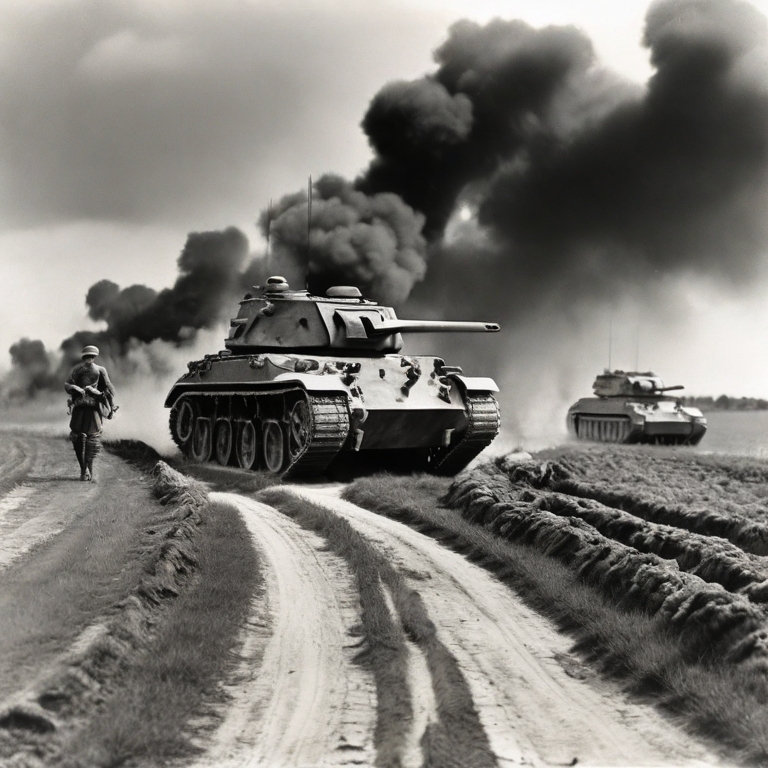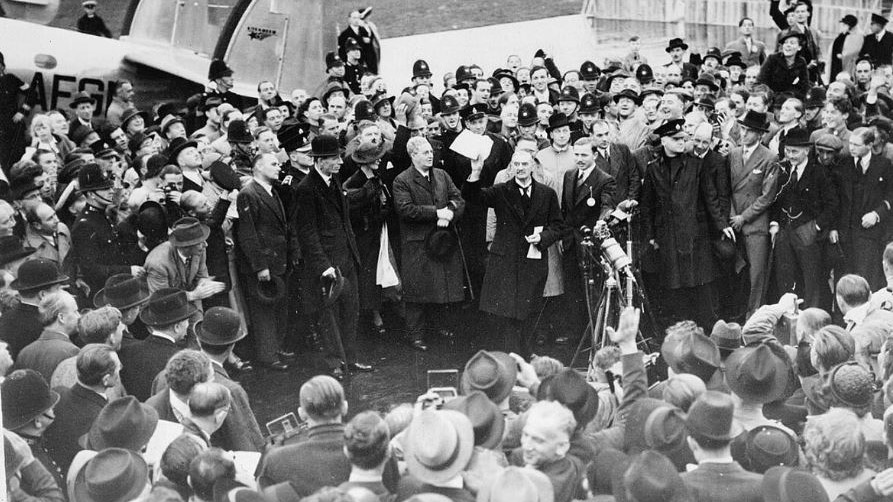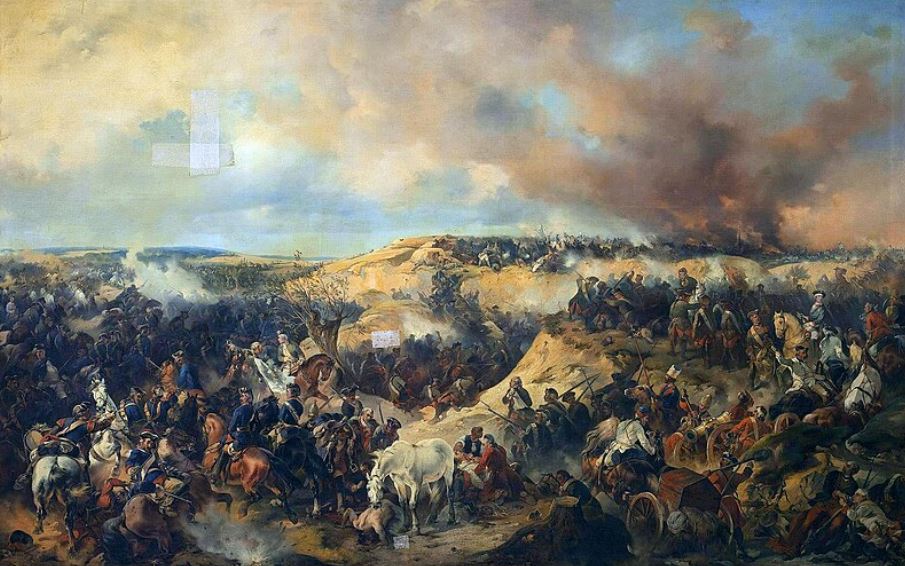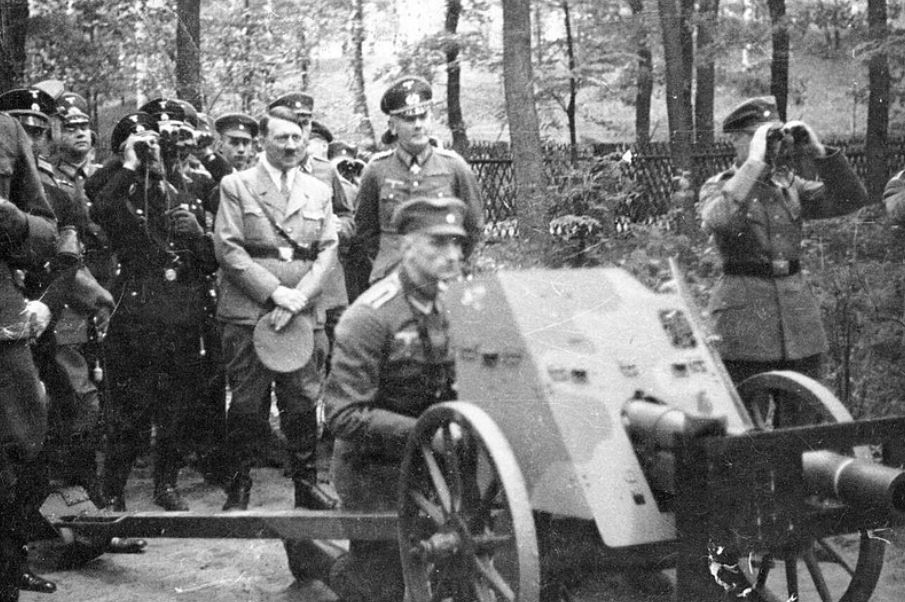Who were the famous “Ghost Division” that operated during World War 2? Rommel’s 7th Panzers were “Ghost Division”.
The 7th Panzers gained this nickname due to its swift and elusive movements on the battlefield, which often led the enemy to believe that the division had mysteriously appeared and disappeared. The sobriquet “Gespensterdivision” or Ghost Division adds an air of mystery to its legacy.
In this article, we explore the role of the Ghost Division in the Battle of France and along the Eastern Front to uncover its legacy within the narrative of World War 2.
1. Ghost Division Origins
The 7th Panzer Division was famously dubbed the Ghost Division. It solidified its reputation as a formidable force during World War 2 through its distinctive characteristics of Lightning Fast Maneuvers and unparalleled efficiency on the European battlegrounds.
Renowned for its swift and dynamic tactics, the Ghost Division played a crucial role in several significant campaigns, including the Blitzkrieg in Poland and decisive victories in France.
Led by General Irwin Rommel, the division’s ability to rapidly advance and adapt to ever-changing situations became a hallmark of its military prowess.
Following the invasion of Poland, a pivotal moment in the early stages of World War 2. Recognizing the limited effectiveness of light divisions, the German High Command ordered the reorganization of the division into a complete Panzer division in October 1939.
This restructuring marked a strategic shift. The division emerged as a fully equipped and versatile force ready for the fast-paced warfare that would come to define the Blitzkrieg.
Under Rommel’s leadership, the Ghost Division swiftly adapted to its new configuration, comprising:
- 218 tanks across three battalions
- Two rifle regiments
- A motorcycle battalion
- An engineer battalion
- An anti-tank battalion
General Rommel, who had previously served on Hitler’s staff during the invasion of Poland, assumed command in February 1940.
Rommel’s leadership style deviated from the conventional. It resembled that of a seasoned company commander rather than a division head.
The enigmatic moniker “Ghost Division” finds its roots in the distinctive tactics employed by Rommel.
By linking Rommel’s unconventional leadership approach to the mysterious and effective tactics of the Ghost Division, a narrative unfolds. The reputation as the ghost division.
2. The Ghost Division in the Battle of France
Rommel’s Ghost Division Leading the Spearhead through the Ardennes
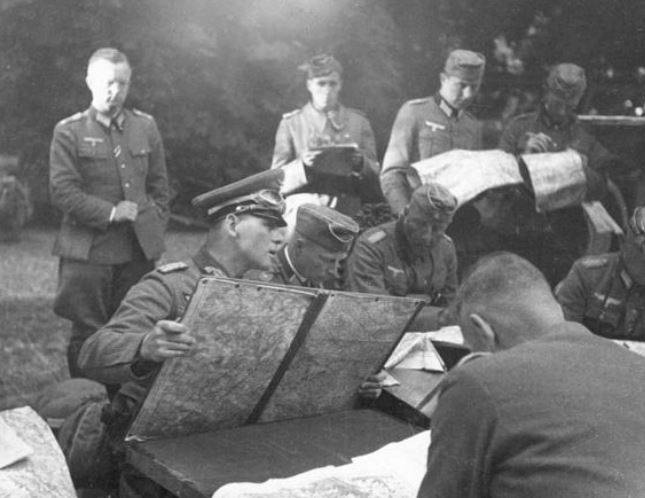
Rommel, known for his aggressive tactics, led the 7th Panzer at the forefront of Army Group A’s attack through the Ardennes.
Their speed and firepower were instrumental in breaching the lightly defended Belgian lines, breaking through key choke points like the Meuse River, and causing widespread panic among Allied forces.
The 7th Panzer’s emphasis on swift armored operations, combined with effective air support, made them a highly effective offensive force in the relatively open terrain of the Ardennes. They disrupted communication lines, sowed confusion, and overwhelmed surprised defenders.
Their speed, firepower, and Rommel’s leadership had a significant impact on the initial success of the German offensive.
Rommel’s Unconventional Tactics at Arras
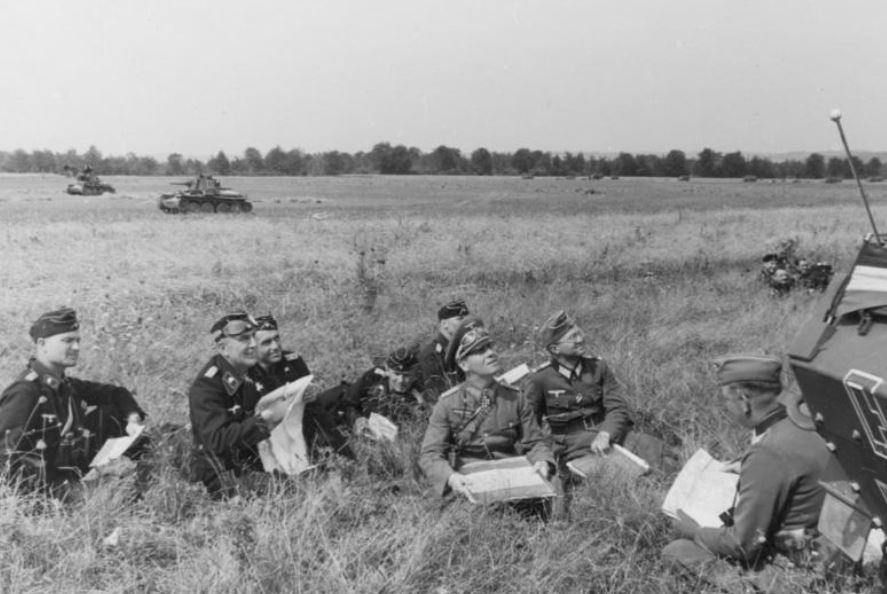
During the Battle of Arras, the Ghost Division found itself confronted with an unexpected British counterattack.
Intense and ferocious fighting characterized this engagement, resulting in heavy casualties for both the Ghost Division and the British forces. Rommel’s leadership skills were put to the test as he navigated the rapidly changing dynamics of the battlefield.
In the face of the British counteroffensive, Rommel’s tactical acumen came to the forefront. Rommel Recognized the need for innovative strategies at Arras, which included:
Repurposing Anti-Aircraft Guns:
When the British launched their surprise attack, Rommel faced a potential breakthrough against his Panzer division.
He recognizing the lack of suitable anti-tank guns, so made a daring decision. To utilize 88mm flak guns instead. These guns were primarily meant for aircraft, against the advancing British tanks. This proved highly effective, as the powerful guns could penetrate the armor of most British tanks at the time.
Decentralized Command and Initiative:
Rommel believed in empowering his subordinate officers to make quick decisions without waiting for orders from higher command. This allowed for adaptability and swift responses to the rapidly changing battlefield situation. During the British counterattack, his junior officers played a crucial role in coordinating tank and infantry movements. This made it difficult for the British to exploit any weaknesses.
Flanking Maneuvers:
Rommel employed his signature tactic of flanking attacks, sending Panzer units around the British flanks to disrupt their formations and cut off their supply lines. This tactic led to confusion and demoralization among the British troops, further contributing to their retreat.
Aggressive Pursuit:
Once the British momentum was broken, Rommel didn’t let up. He ordered a relentless pursuit, harrying the retreating British forces and preventing them from regrouping. This aggressive approach put further pressure on the British and contributed to their overall defeat in the Battle of France.
While Rommel’s tactics at Arras proved successful, it’s important to note that the battle came at a heavy cost for both sides. The use of unconventional weaponry and aggressive tactics led to significant casualties on both the German and British sides.
However, the Battle of Arras ultimately solidified Rommel’s reputation as a bold and innovative commander. His leadership here lay the groundwork for his future successes in North Africa.
The Ghost Division: Defying Orders, Achieving Success
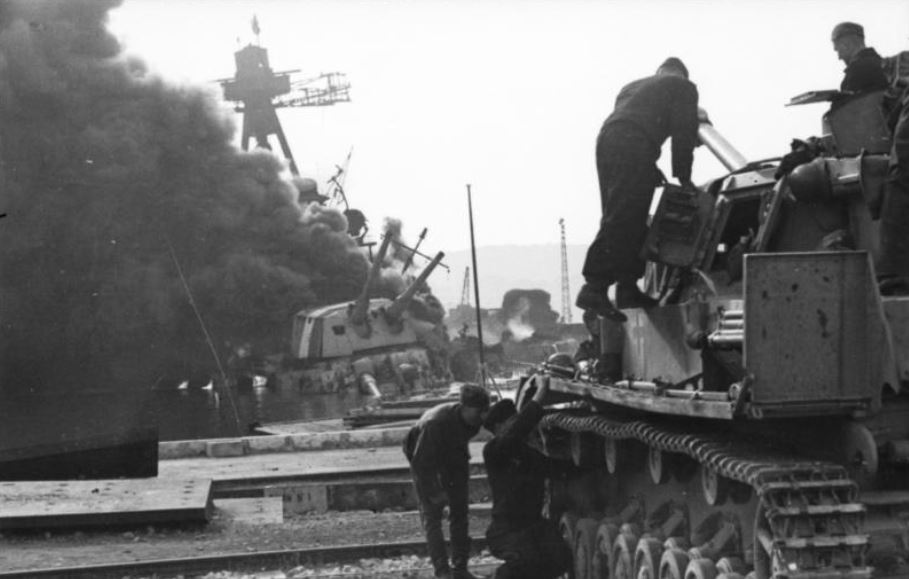
Towards the end of May 1940, despite Hitler’s halt order, which temporarily suspended the Ghost Division’s advance in France, Rommel’s decisive leadership once again came to the fore.
Under Rommel’s command, the Ghost Division defied the order and resumed its push forward into France. This resumption of the advance proved pivotal. It led to the surrender of the French Garrison at Lille and the advance on Dunkirk.
The reasons for his disobedience included:
- Momentum and Operational Speed: Rommel and his troops were in the midst of a rapid advance, and stopping abruptly could disrupt their momentum and expose them to enemy counterattacks.
- Incomplete Communication: It’s possible the full details of the halt order hadn’t yet reached Rommel and his division, or there might have been confusion regarding its exact application.
- Independent Initiative: Rommel was known for his bold and independent leadership, sometimes pushing the boundaries of orders to achieve his objectives. In this case, capturing Lille and potentially trapping more Allied forces at Dunkirk might have seemed strategically advantageous.
Rommel’s audacious maneuvers, pushing beyond orders, helped trap the Allied forces in northern France. This created the urgent need for evacuation, as the British Expeditionary Force (BEF) faced encirclement by the German army.
However, Rommel’s advance also stretched German supply lines and resources. This meant the Germans couldn’t capitalize on their advantage as quickly as they might have, giving the Allies some precious time to organize the evacuation and solidify their perimeter around Dunkirk and complete the evacuation.
3. The Ghost Division Along the Eastern Front
The 7th Panzer Division “Ghost Division” also played a crucial role on the Eastern Front during World War 2.
It would be without Rommel as in February 1941, he was appointed as the commander of the newly formed Afrika Korps (Deutsches Afrika Korps; DAK) to serve in North Africa.
Operation Barbarossa: Initial Advance and Resistance
During Operation Barbarossa, the Ghost Division, played a significant role in the initial advance of the German forces into the Soviet Union. As part of Army Group Center, the division swiftly pushed forward, capturing bridges and establishing bridgeheads.
The Ghost Division’s rapid advance caught the Soviet 5th Tank Division stationed at Alytus on the east bank of the Neman River completely by surprise. The German forces encountered little resistance initially, allowing them to make significant progress.
However, as the division continued its advance, it encountered fierce Soviet resistance. The well-equipped Soviet 5th Tank Division, equipped with formidable tanks like the T-34 and KV-1, inflicted combat losses on the German panzer forces. The Soviets launched counter-attacks, causing the German advance to come to an abrupt halt.
Stemming the Soviet Advance at Rostov
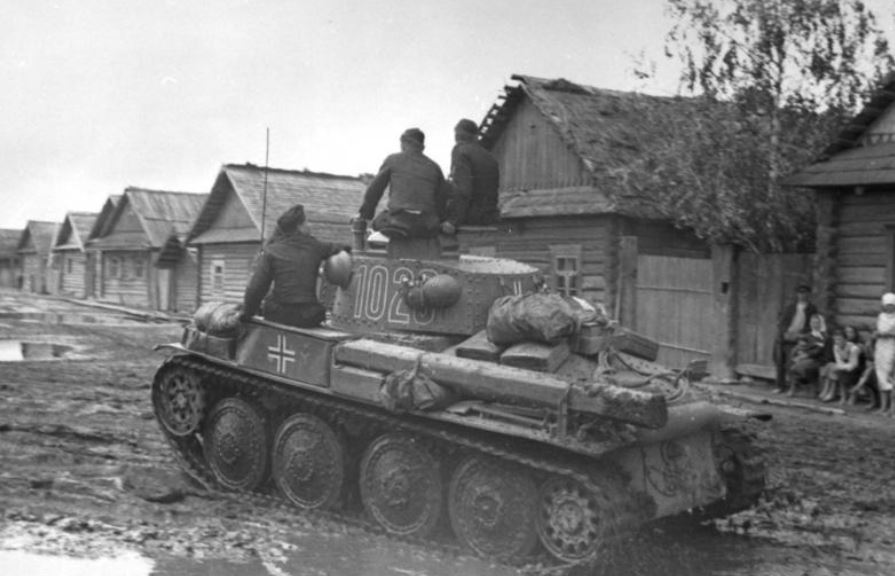
Following the initial advance, the Ghost Division was transferred to Army Group South. Its new objective was to halt the Soviet effort to cut off the 1st Panzer Army in the Caucasus and maintain an escape route at Rostov.
The division’s presence and defensive actions played a crucial role in preventing the Soviets from achieving their goal. By effectively countering the Soviet advance, the Ghost Division ensured that the 1st Panzer Army had a viable avenue of escape.
The division’s determination and successful defense at Rostov demonstrated its resilience and ability to fulfill critical objectives in the face of intense enemy pressure.
Defensive Operations along the Don and Donetz Rivers
After he successful defense at Rostov, the Ghost Division was involved in defensive operations along the Don and Donetz rivers. Positioned along these strategic river lines, the division played a crucial role in holding key defensive positions.
The division’s task was to defend against Soviet offensives and prevent any breakthroughs along the river lines. It engaged in intense combat, utilizing its remaining tanks and infantry forces to repel Soviet attacks and maintain the German defensive front.
The Third Battle of Kharkov
One of the notable engagements for the Ghost Division was its participation in the Third Battle of Kharkov. The battle took place in early 1943 and was a major German attempt to recapture the city of Kharkov from Soviet control.
The division, alongside other German units, launched a counteroffensive against Soviet forces that had seized Kharkov. The Ghost Division played a significant role in the fighting, seeking to regain control of the city and drive back the Soviet troops.
Intense and bitter fighting characterized the battle, with both sides sustaining heavy casualties. Despite their efforts, the German forces, including the Ghost Division, were unable to fully achieve their objectives, and the battle eventually resulted in a Soviet victory.
The Offensive at Kursk and Heavy Losses
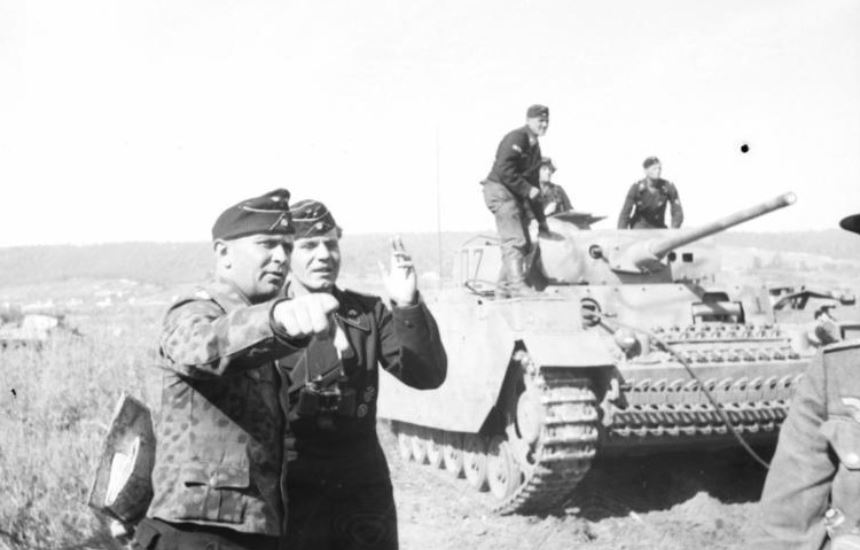
In the summer of 1943, the Ghost Division participated in the offensive at Kursk. This was a major German offensive launched against the Kursk salient in the Soviet Union.
As part of Army Detachment Kempf, the division was tasked with screening the eastern flank of the southern German pincer. However, the offensive at Kursk proved to be a turning point in the war, as Soviet defenses were well-prepared, and the Germans faced fierce resistance.
The Ghost Division suffered heavy casualties and significant equipment losses during the intense and brutal battles at Kursk. By the end of the offensive, the division’s tank and infantry strength was greatly diminished.
The losses suffered by the Ghost Division at Kursk highlighted the ferocity of the battle and the formidable Soviet defenses. It marked a significant setback for the division and highlighted the challenges faced by the German forces on the Eastern Front.
4. The Ghost Division’s Decline
After the Battle of Kursk, the Ghost Division underwent significant changes.
Reorganization and Transfer
Following the heavy losses suffered at Kursk, the Ghost Division underwent a period of reorganization and refitting. Efforts were made to replenish its ranks and replace the lost equipment.
The division was transferred from Army Group Center to the XLVIII Panzer Corps. At this stage, General Major Hasso von Manteuffel assumed command of the division.
Defensive Battles and Withdrawal
The Ghost Division played a role in defensive battles as the German forces began a strategic withdrawal from the Eastern Front. It fought in various engagements aimed at slowing down the advancing Soviet forces and providing cover for the German retreat.
The division participated in defensive operations along the Dnieper River line. Their aim was hold back the Soviet forces and buy time for the German Army to regroup and establish new defensive positions.
Long Retreat and Rearguard Actions
During the long retreat across Ukraine, the Ghost Division engaged in a series of rearguard actions. These actions involved delaying the Soviet pursuit, inflicting casualties, and disrupting enemy advances to protect the retreating German forces.
The division fought tenaciously, often facing overwhelming odds. However, the constant pressure and numerical superiority of the Soviet forces made it increasingly challenging to hold ground and maintain cohesive defensive formations.
Consolidation and Losses
Throughout the defensive battles and the retreat, the Ghost Division suffered significant personnel and equipment losses. Its combat effectiveness was further reduced, leading to the consolidation of remaining operational tanks into a single company.
It remained engaged in the fight on the Eastern Front, although its strength and capabilities were significantly diminished compared to its earlier operations.
5. The Ghost Division’s Legacy
The Ghost Division, despite facing immense challenges and losses, left a lasting legacy on the Eastern Front in World War 2.
Renowned for their tenacity and resilience, the division fought with unwavering determination in intense battles against overwhelming odds.
Their defensive expertise and rearguard actions showcased their ability to slow down the Soviet advance and protect retreating German forces.
The division’s adaptability and flexibility allowed them to adjust tactics and strategies to changing circumstances on the battlefield.
Their contributions to German military history, particularly in major battles like Operation Barbarossa and the Battle of Kursk, have added to the understanding of the challenges faced by German forces on the Eastern Front.

